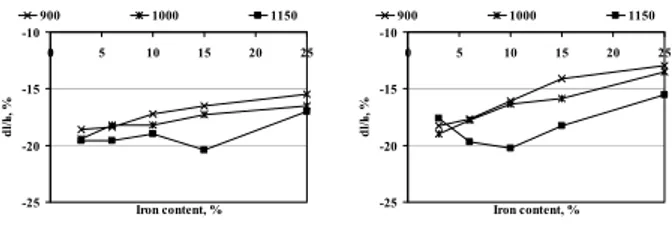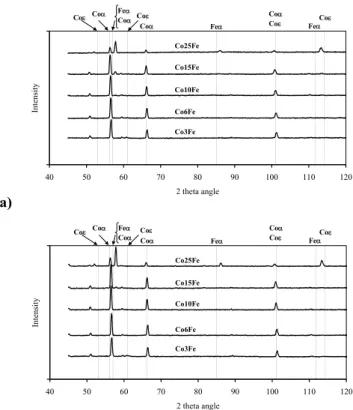© Korean Powder Metallurgy Institute 1126 -1. Introduction
Cobalt has two allotropic forms: a closed-packed hexa-gonal (ε), stable at temperatures below 421OC, and a
face-centred cubic (α), stable at higher temperatures. These allotropic phases are characterised by different properties: the phase ε is much more brittle and harder then phase α [3]. Then, it is obvious that cobalt’s properties depend on its phase composition. From the cobalt-iron phase diagram [4] it is evident, that addition up to 10 wt.% Fe strongly stabilise the cubic phase, and in a consequence, imparting ductility to the material, which factor has been found beneficial to the matrix with regard to its diamond retention capacity [1,5]. Further additions of iron to cobalt may lead to formation of a brittle, ordered α' phase, which is stable at room temperature in alloys containing between 25÷75 wt.% Fe [6,7]. But this situation can change when powder metalurgy materials are considered. The main objective of this work was to study the sintering behaviour of selected cobalt-iron materials obtained by the conventional powder metallurgy technique, in the aspect of application in diamond tools industry.
2. Experimental and Results
The mixtures of commercial, elemental powders, containing various proportions of cobalt extrafine to
carbonyl iron powder were prepared by mixing in Turbula
for 30 min. The 5x5x15 mm specimens were obtained from the mixtures containing 3, 6, 10, 15 and 25 wt.% iron by cold pressing under pressure of 400 MPa: Sintering was carried out in the Netzesch 402E dilatometer at 900, 1000 and 1150OC, either in hydrogen or nitrogen atmosphere.
The heating and cooling rate were set at 10K/min.; specimens were hold at the temperature for one hour.
The length of specimens during sintering were monitored to establish the overall shrinkage. Microstructural
obser-vations were carried out on polished and etched transverse sections using Leica DM4000M light microscope using differential interference contrast mode. Also materials were subjected for X-ray phase analysis.
On Figures 1 is presented the overall shrinkage of the samples after sintering.
Depending on the applied atmosphere, the temperature varies, at which the sintering material begins to shrink - Table 1.
Selected X-ray diffractograms recorded on the sintered parts are presented on Figure 2, whereas the microstructures on Figures 3.
3. Summary
The results obtained from dilatometry have shown, that during heating to the sintering temperature, the dimensional changes of the samples are significant. The effect of iron
-25 -20 -15 -10 0 5 10 15 20 25 Iron content, % dl/ l 0 , % 900 1000 1150 -25 -20 -15 -10 0 5 10 15 20 25 Iron content, % dl/ l0 , % 900 1000 1150 (a) (b)
Fig. 1. Parts’ overall shrinkage sintered in; a) H2; b) N2. Table 1. Temperature of the sintering beginning.
The shrink starts at [OC]
Designation sintering in H 2 sintering in N2 Co3Fe 454 454 Co6Fe 463 504 Co10Fe 460 536 Co15Fe 458 521 Co25Fe 439 513 2006 POWDER METALLURGY World Congress PC06-W-02
Sintering of Cobalt - (3-25 wt.%) Iron Materials
Andrzej Romanski
AGH-University of Science and Technology, Cracow, Poland aromansk@agh.edu.pl
Abstract
The kinetics of sintering of Co-Fe materials was studied. The main objective was to establish the effects of iron content and sintering parameters on the microstructure and phase composition of the as-sintered material. Specimens containing from 3 to 25 wt.% iron were sintered in a dilatometer for one hour at 900, 1000 and 1150OC in either hydrogen or nitrogen
atmosphere. The length of specimens during the heating, hold at temperature and cooling steps were monitored to establish the sample’s shrinkage. Microstructural observations were carried out on polished and etched transverse sections which were also subjected to the X-ray phase analysis.
© Korean Powder Metallurgy Institute 1127 -a) 40 50 60 70 80 90 100 110 120 2 theta angle Intensity Coε Coα FeCoααCoε Coα Feα Coα Coε FeαCoε Co3Fe Co6Fe Co10Fe Co15Fe Co25Fe b) 40 50 60 70 80 90 100 110 120 2 theta angle Intensity Coε Coα Feα Coα CoCoεα Feα Coα Coε FeαCoε Co3Fe Co6Fe Co10Fe Co15Fe Co25Fe
Fig. 2. X-ray patterns. Temperature 900OC, a) H2; b) N2.
Co3Fe, 900OC, H2 Co15Fe, 900OC, H2
Co3Fe, 900OC, N2 Co15Fe, 900OC, N2 Fig. 3. Microstructure of the Co3Fe, Co15Fe materials. addition on the sintering behaviour of the investigated materials is evident. The higher iron content the smaller shrinkage of the parts is a good genaral rule. It has been found that specimens sintered at higher temperature are characterised by greater dimensional changes, what is the effect of more intensive diffusion, what taking place during sintering. The applied atmosphere is of secondary importance when dimensional changes of the specimens are consiered. There is only appreciable effect of the atmo-sphere on the temperature at which the material begins to
shrink - Table 2. Except material containing 3% iron, samples sintered in nitrogen start to shrink at temperature about 63OC higher (average value) in comparision with
their counterparts sintered in hydrogen. For this effect is probably responsible the higher amount of unreduced cobalt and iron oxides presented on the particle surfaces, which hinder the diffusion process. Results obtained from the X-ray diffraction have proved that even small addition of iron stabilises the cobalt’s α phase. The shifted position of the peaks with regard to the patterns is the consequence of a cobalt-iron solid solution formation, which is accelerated by the higher sintering temperature - Fig.3. The investigated materials are characterised by the homogenous microstructure. For the higher sintering temperature, it can be seen the effect of a grain-growth process. The grains become greater, with high amount of the twins formed during recrystallisation. When the effect of the applied atmosphere is considered, there are minor differences between microstructure of the materials. Sintering in nitrogen leads to higher amount of oxides, which hinder the grain growth and recrystallisation process.
4. References
1. J. Konstanty: Cobalt as a Matrix in Diamond Impregnated Tools for Stone Sawing Applications (AGH Uczelniane Wydawnictwa Naukowo-Dydaktyczne, Cracow, Poland, 2002).
2. J. Konstanty, A. Romanski, H. Frydrych: Proc. of PM 2000 Powder World Congress & Exhibition, Kyoto, Japan, Part 2, (2000), p. 1629.
3. W. Betteridge: Cobalt and its alloys (Ellis Horwood Limited Publishers, Chichester, 1982).
4. T.B. Massalski: Binary alloy diagrams (American Society for Metals, Ohio, 1986)
5. J.D. Dwan: Industrial Diamond Review, 2/03, (2003), p. 50.
6. J. Konstanty, W. Ratuszek, J. Jamrozek, I. Olszewska: International Journal of Powder Metallurgy, vol. 40, issue 1, (2004), p. 41.
7. J. Konstanty, W. Ratuszek, J. Jamrozek: Proc. of World Congress & Exhibition on Powder Metallurgy, Vienna, Austria, vol. 3, (2004), p. 669.
This work has been financed by the Polish Ministry of Education and Science through the contract no. 3 T08D 059 30.
20 µm 20 µm

